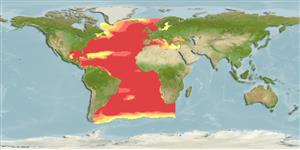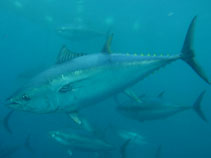添加你自己的观测位置在 Fish Watcher
| Native range | All suitable habitat | Point map | Year 2050 |

|
| This map was computer-generated and has not yet been reviewed. |
| Thunnus thynnus AquaMaps Data sources: GBIF OBIS |
上传你的 图片 和 影像
Pictures | Videos | Stamps, coins, misc. | 谷歌图片Thunnus thynnus
Picture by Ticina, V.
Pictures | Videos | Stamps, coins, misc. | 谷歌图片Thunnus thynnus
Picture by Ticina, V.
Common names from other countries
分类 / Names 俗名 | 同种异名 | Catalog of Fishes(属, 种) | ITIS | CoL | WoRMS | Cloffa
Teleostei > Scombriformes (Mackerels) > Scombridae (Mackerels, tunas, bonitos) > Scombrinae
Etymology: Thunnus: Greek, thynnos = tunna (Ref. 45335).
More on author: Linnaeus.
Etymology: Thunnus: Greek, thynnos = tunna (Ref. 45335).
More on author: Linnaeus.
Environment: milieu / climate zone / depth range / distribution range 生态学
海洋; 半咸淡水; 海洋洄游的 (Ref. 51243); 深度上下限 0 - 985 m (Ref. 55291), usually 0 - 100 m. 亞熱帶的; 3°C - 30°C (Ref. 88796); 69°N - 58°S, 99°W - 42°E
分布 国家 | FAO区域 | 生态系 | 标本纪录 | Point map | 简介 | Faunafri
Western Atlantic: Labrador and Newfoundland to Gulf of Mexico, and Caribbean Sea to Venezuela and Brazil. Eastern Atlantic: Lofoten Islands off Norway to Canary Islands, including the Mediterranean and the southern part of the Black Sea (Ref. 6769). Reported from Mauritania (Ref. 5377). There is a subpopulation off South Africa. Highly migratory species.
西大西洋: 加拿大,墨西哥灣 , 與加勒比海到委內瑞拉與巴西。 東大西洋: Lofoten 島外海的挪威到加納利群島, 包括地中海與黑海的南部.(參考文獻 6769) 記錄來自茅利塔尼亞了。 (參考文獻 5377) 有一個子族群南非外海。 高度遷移的種,1982年海事法會議的附件一.(參考文獻 26139)
西大西洋: 加拿大,墨西哥灣 , 與加勒比海到委內瑞拉與巴西。 東大西洋: Lofoten 島外海的挪威到加納利群島, 包括地中海與黑海的南部.(參考文獻 6769) 記錄來自茅利塔尼亞了。 (參考文獻 5377) 有一個子族群南非外海。 高度遷移的種,1982年海事法會議的附件一.(參考文獻 26139)
Length at first maturity / 大小 / 重量 / 年龄
Maturity: Lm 103.5, range 97 - 110 cm
Max length : 458 cm TL 雄鱼/尚未辨别雌雄; (Ref. 26340); common length : 200 cm FL 雄鱼/尚未辨别雌雄; (Ref. 168); 最大体重: 684.0 kg (Ref. 26340); 最大年龄: 32 年 (Ref. 5810)
Max length : 458 cm TL 雄鱼/尚未辨别雌雄; (Ref. 26340); common length : 200 cm FL 雄鱼/尚未辨别雌雄; (Ref. 168); 最大体重: 684.0 kg (Ref. 26340); 最大年龄: 32 年 (Ref. 5810)
简单描述 检索表 | 型态特徵 | 形态测量图
背棘 (总数) : 12 - 14; 背的软条 (总数) : 13 - 15; 臀棘: 0; 臀鳍软条: 13 - 16; 脊椎骨: 39. A very large species, deepest near the middle of the first dorsal fin base. The second dorsal fin higher than the first; the pectoral fins are very short, less than 80% of head length. Swim bladder present. Lower sides and belly silvery white with colorless transverse lines alternated with rows of colorless dots. The first dorsal fin is yellow or bluish; the second reddish-brown; the anal fin and finlets dusky yellow and edged with black; the median caudal keel is black in adults. May be confused with several other tunas, these are typically much smaller and easily distinguished by specific patterns of stripes, bands or dots.
一个非常大的种, 深的在第一背鳍基底的中央的附近。 比第一个高的第二个背鳍; 胸鳍非常短, 少于 80% 的头长。 有泳鳔。 下侧与腹面银白色有无色的与列的无色点一起轮流的横切线。 第一背鳍是黄色或蓝色的; 第二个红褐色的; 臀鳍与离鳍暗黄色而且有黑色边缘了; 中央的尾部龙骨脊是黑色的当成鱼时。
一个非常大的种, 深的在第一背鳍基底的中央的附近。 比第一个高的第二个背鳍; 胸鳍非常短, 少于 80% 的头长。 有泳鳔。 下侧与腹面银白色有无色的与列的无色点一起轮流的横切线。 第一背鳍是黄色或蓝色的; 第二个红褐色的; 臀鳍与离鳍暗黄色而且有黑色边缘了; 中央的尾部龙骨脊是黑色的当成鱼时。
Oceanic but seasonally coming close to shore. They school by size, sometimes together with albacore, yellowfin, bigeye, skipjack etc. Visual predators (Ref. 88866) preying on small schooling fishes (anchovies, sauries, hakes) or on squids and red crabs. Live up to 40 years in the western Atlantic (Ref. 88822). Weight up to 900 kg (Ref. 88823). Eggs and larvae are pelagic (Ref. 6769). Juvenile growth is rapid (about 30 cm / year) but slower than in other tuna
and billfish species (Ref. 88867). Adult growth is considerably slower, with about 10 years needed to reach two thirds of maximum length. Become rare because of massive overfishing (Ref. 35388).
大洋性的但是季节性地接近海岸而且能容忍宽范围的温度。 他们鱼群依大小, 有时伴随着巴鲣鱼,黄鳍, bigeye, 纵带鰺等等捕食小的群游性鱼 ( 鱼,针鱼, 鳕鱼) 或在乌贼与红色的螃蟹上。 商业地在日本养殖。 生鲜使用用作生鱼片, 也将.装于罐头 (参考文献 9988) 变成稀有的由于大量的过度捕捞。 (参考文献 35388)
大洋性的但是季节性地接近海岸而且能容忍宽范围的温度。 他们鱼群依大小, 有时伴随着巴鲣鱼,黄鳍, bigeye, 纵带鰺等等捕食小的群游性鱼 ( 鱼,针鱼, 鳕鱼) 或在乌贼与红色的螃蟹上。 商业地在日本养殖。 生鲜使用用作生鱼片, 也将.装于罐头 (参考文献 9988) 变成稀有的由于大量的过度捕捞。 (参考文献 35388)
Life cycle and mating behavior 成熟度 | 繁殖 | 产卵场 | 卵 | 孕卵数 | 仔鱼
Oviparous batch spawner, with an inter-spawning interval of 1-2 days in the Mediterranean Sea (Ref. 88871). Females larger than 205 cm fork length are estimated to have a mean fecundity of 30-60 and 13-15 million eggs, in the western and eastern Atlantic respectively (Ref. 40805, Ref. 88871). Spawning occurs when sea surface temperatures are between 22.6-27.5 ºC and 22.5-25.5 ºC in the Gulf of Mexico and Mediterranean Sea respectively (88868). Spawning occurs between June and August in the Mediterranean Sea (Ref. 88868). Eggs are released directly to the water column and hatch after 2 days (Ref. 88823). At 24°C, embryo development lasts about 32 hours and larval stages about 30 days. Egg size 1.0 mm, larval length at hatching 2.8 mm.
Spawning grounds are mainly known from the Gulf of Mexico and the Mediterranean Sea, but the presence of mature individuals and larvae far from these areas (e.g. Bahamas and central North Atlantic Ocean) suggest that other spawning grounds may also be utilized (Ref. 88873, Ref. 88874, Ref. 88872). Appears to display homing behaviour with (western-tagged individuals migrating back to specific spawning sites either in the Gulf of Mexico or the Mediterranean Sea) (Ref. 88872, Ref. 88870). Fidelity to natal areas seem to occur once individuals reach maturity, i.e. after returning to either the western or eastern spawning grounds (Ref. 88868).
西大西洋: 加拿大,墨西哥灣 , 與加勒比海到委內瑞拉與巴西。 東大西洋: Lofoten 島外海的挪威到加納利群島, 包括地中海與黑海的南部.(參考文獻 6769) 記錄來自茅利塔尼亞了。 (參考文獻 5377) 有一個子族群南非外海。 高度遷移的種,1982年海事法會議的附件一.(參考文獻 26139)
主要参考文献
Upload your references | 参考文献 | 合作者 : Collette, Bruce B. | 合作者
Collette, B.B., 1999. Mackerels, molecules, and morphology. p. 149-164. In B. Séret and J.-Y. Sire (eds.) Proc. 5th Indo-Pac. Fish Conf., Noumea, Paris. (Ref. 33246)
对人类的威胁
无害处的
人类利用
渔业: 商业性; 养殖: 商业性; 游钓鱼种: 是的
FAO(Aquaculture systems: 产生; 渔业: 产生, 物种外形; publication : search) | FIRMS (Stock assessments) | FishSource | 周边海洋
更多信息
Population dynamics
成长参数
Max. ages / sizes
Length-weight rel.
Length-length rel.
体长-频率
Mass conversion
入添量
丰度
成长参数
Max. ages / sizes
Length-weight rel.
Length-length rel.
体长-频率
Mass conversion
入添量
丰度
Physiology
Body composition
Nutrients
耗氧量
游泳类型
游泳速度
Visual pigments
Fish sound
Diseases & Parasites
Toxicity (LC50s)
Body composition
Nutrients
耗氧量
游泳类型
游泳速度
Visual pigments
Fish sound
Diseases & Parasites
Toxicity (LC50s)
工具
Bio-Quiz | E-book | 野外调查 | 检索表 | 长度- 频率 Wizard | 生活- 历史的工具 | 分布图 | Classification Tree
| Catch-MSY |
特别资料
下载 XML
网络资源
Aquatic Commons | BHL | Cloffa | BOLDSystems | Websites from users | 核实 FishWatcher | CISTI | Catalog of Fishes(属, 种) | DiscoverLife | ECOTOX | Faunafri | Fishtrace | GenBank(基因组, 核苷酸) | GloBI | GOBASE | | Google Books | Google Scholar | Google | IGFA World Record | MitoFish | 国家资料库 | Otolith Atlas of Taiwan Fishes | 公众的水族馆 | PubMed | Reef Life Survey | Scirus | SeaLifeBase | 树状分类阶层 | Wikipedia(转至, 搜寻) | World Records Freshwater Fishing | 动物学的记录
Estimates based on models
Preferred temperature (Ref. 115969): 7.5 - 24.7, mean 12.6 (based on 3084 cells).
Phylogenetic diversity index (Ref. 82804): PD50 = 0.5039 [Uniqueness, from 0.5 = low to 2.0 = high].
Bayesian length-weight: a=0.01230 (0.01003 - 0.01509), b=3.03 (2.99 - 3.07), in cm Total Length, based on LWR estimates for this species (Ref. 93245).
营养阶层 (Ref. 69278): 4.5 ±0.8 se; based on diet studies.
回复力 (Ref. 120179): 中等的, 族群倍增时间最少 1.4 - 4.4年 (tm=3-5; tmax=15; Fec=10 million).
Prior r = 0.24, 95% CL = 0.16 - 0.35, Based on 5 full stock assessments.
Fishing Vulnerability (Ref. 59153): Very high vulnerability (82 of 100).
Climate Vulnerability (Ref. 125649): Moderate vulnerability (38 of 100).




